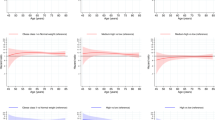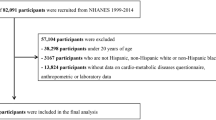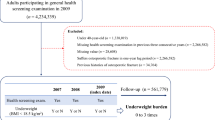Abstract
Objective:
To quantify the risk of hospital admission in relation to fine increments in body mass index (BMI).
Design, setting and participants:
Population-based prospective cohort study of 246 361 individuals aged ⩾45 years, from New South Wales, Australia, recruited from 2006–2009. Self-reported data on BMI and potential confounding/mediating factors were linked to hospital admission and death data.
Main outcomes:
Cox-models were used to estimate the relative risk (RR) of incident all-cause and diagnosis-specific hospital admission (excluding same day) in relation to BMI.
Results:
There were 61 583 incident hospitalisations over 479 769 person-years (py) of observation. In men, hospitalisation rates were lowest for BMI 20–<25 kg m−2 (age-standardised rate:120/1000 py) and in women for BMI 18.5–<25 kg m−2 (102/1000 py); above these levels, rates increased steadily with increasing BMI; rates were 203 and 183/1000 py, for men and women with BMI 35–50 kg m−2, respectively. This pattern was observed regardless of baseline health status, smoking status and physical activity levels. After adjustment, the RRs (95% confidence interval) per 1 kg m−2 increase in BMI from ⩾20 kg m−2 were 1.04(1.03–1.04) for men and 1.04(1.04–1.05) for women aged 45–64; corresponding RRs for ages 65–79 were 1.03(1.02–1.03) and 1.03(1.03–1.04); and for ages ⩾80 years, 1.01(1.00–1.01) and 1.01(1.01–1.02). Hospitalisation risks were elevated for a large range of diagnoses, including a number of circulatory, digestive, musculoskeletal and respiratory diseases, while being protective for just two—fracture and hernia.
Conclusions:
Above normal BMI, the RR of hospitalisation increases with even small increases in BMI, less so in the elderly. Even a small downward shift in BMI, among those who are overweight not just those who are obese, could result in a substantial reduction in the risk of hospitalisation.
This is a preview of subscription content, access via your institution
Access options
Subscribe to this journal
Receive 12 print issues and online access
$259.00 per year
only $21.58 per issue
Buy this article
- Purchase on Springer Link
- Instant access to full article PDF
Prices may be subject to local taxes which are calculated during checkout



Similar content being viewed by others
References
Organisation for Economic Co-operation and Development. Obesity and the Economics of Prevention: Fit not Fat. OECD: Paris, 2010.
Berrington de Gonzalez A, Hartge P, Cerhan JR, Flint AJ, Hannan L, MacInnis RJ et al. Body-mass index and mortality among 1.46 million white adults. N Engl J Med 2011; 363: 2211–2219.
Whitlock G, Lewington S, Sherliker P, Clarke R, Emberson J, Halsey J et al. Body-mass index and cause-specific mortality in 900 000 adults: collaborative analyses of 57 prospective studies. Lancet 2009; 373: 1083–1096.
Guh DP, Zhang W, Bansback N, Amarsi Z, Birmingham CL, Anis AH . The incidence of co-morbidities related to obesity and overweight: a systematic review and meta-analysis. BMC Public Health 2009; 9: 88.
Han E, Truesdale KP, Taber DR, Cai J, Juhaeri J, Stevens J . Impact of overweight and obesity on hospitalization: race and gender differences. Int J Obes (Lond) 2009; 33: 249–256.
Hart CL, Hole DJ, Lawlor DA, Smith GD . Obesity and use of acute hospital services in participants of the Renfrew/Paisley study. J Public Health (Oxf) 2007; 29: 53–56.
Schafer MH, Ferraro KF . Obesity and hospitalization over the adult life course: does duration of exposure increase use? J Health Soc Behav 2007; 48: 434–449.
Borg S, Persson U, Odegaard K, Berglund G, Nilsson JA, Nilsson PM . Obesity, survival, and hospital costs-findings from a screening project in Sweden. Value Health 2005; 8: 562–571.
Luchsinger JA, Lee WN, Carrasquillo O, Rabinowitz D, Shea S . Body mass index and hospitalization in the elderly. J Am Geriatr Soc 2003; 51: 1615–1620.
Yan LL, Daviglus ML, Liu K, Stamler J, Wang R, Pirzada A et al. Midlife body mass index and hospitalization and mortality in older age. JAMA 2006; 295: 190–198.
Quesenberry CP, Caan B, Jacobson A . Obesity, health services use, and health care costs among members of a health maintenance organization. Arch Intern Med 1998; 158: 466–472.
Banks E, Redman S, Jorm L, Armstrong B, Bauman A, Beard J et al. Cohort profile: the 45 and up study. Int J Epidemiol 2008; 37: 941–947.
National Centre for Classification in Health. The International Statistical Classification Of Diseases And Related Health Problems, 10th revision, Australian Modification (ICD-10-AM) 3rd edn. University of Sydney: Sydney, 2002.
CHeReL. Centre for Health Record Linkage. < http://www.cherel.org.au >, 2011.
World Health Organization. WHO: Global database on body mass index < http://apps.who.int/bmi/index.jsp?introPage=intro_3.html >, 2006.
Begg S, Vos T, Barker B, Stevenson C, Stanley L, Lopez A . The burden of disease and injury in Australia 2003. AIHW cat. no. PHE 82. Australian Institute of Health and Welfare: Canberra, 2007.
Australian Institute of Health and Welfare. The Active Australia Survey: A Guide and Manual for Implementation, Analysis and Reporting. Canberra: AIHW, 2003.
Brown WJ, Burton NW, Marshall AL, Miller YD . Reliability and validity of a modified self-administered version of the Active Australia physical activity survey in a sample of mid-age women. Aust NZ J Public Health 2008; 32: 535–541.
Australian Institute of Health and Welfare. Rural, regional and remote health: a guide to remoteness classifications. Rural health series No. 4. AIHW cat. no. PHE 53. AIHW: Canberra, 2004.
Harvard University Institute for Health Metrics and Evaluation at the University of Washington Johns Hopkins University, University of Queensland World Health Organization. The Global Burden of Diseases, Injuries, and Risk Factors Study, Operations Manual Final Draft 2009.
Stata statistical software: release 10.1 [program].. StataCorp LP: College Station, TX, 2009.
Australian Bureau of Statistics. National Health Survey: Summary of Results 2007–08. ABS cat. no. 4364.0. ABS: Canberra, 2009.
Strate LL, Liu YL, Aldoori WH, Syngal S, Giovannucci EL . Obesity increases the risks of diverticulitis and diverticular bleeding. Gastroenterology 2009; 136: 115–122 e1.
Young T, Peppard PE, Taheri S . Excess weight and sleep-disordered breathing. J Appl Physiol 2005; 99: 1592–1599.
Pan A, Sun Q, Czernichow S, Kivimaki M, Okereke OI, Lucas M et al. Bidirectional association between depression and obesity in middle-aged and older women. Int J Obes (Lond) 2012; 36: 595–602.
Karppelin M, Siljander T, Vuopio-Varkila J, Kere J, Huhtala H, Vuento R et al. Factors predisposing to acute and recurrent bacterial non-necrotizing cellulitis in hospitalized patients: a prospective case-control study. Clin Microbiol Infect 16: 729–734.
Ruhl CE, Everhart JE . Risk factors for inguinal hernia among adults in the US population. Am J Epidemiol 2007; 165: 1154–1161.
Lam JC, Ip MS . Sleep & the metabolic syndrome. Indian J Med Res 2010; 131: 206–216.
Dimitri P, Bishop N, Walsh JS, Eastell R . Obesity is a risk factor for fracture in children but is protective against fracture in adults: A paradox. Bone 2011; 48: 189–196.
Jelovsek JE, Maher C, Barber MD . Pelvic organ prolapse. Lancet 2007; 369: 1027–1038.
Ni Mhurchu C, Rodgers A, Pan WH, Gu DF, Woodward M . Body mass index and cardiovascular disease in the Asia-Pacific Region: an overview of 33 cohorts involving 310 000 participants. Int J Epidemiol 2004; 33: 751–758.
Gorber SC, Tremblay M, Moher D, Gorber B . A comparison of direct vs self-report measures for assessing height, weight and body mass index: a systematic review. Obes Rev 2007; 8: 307–326.
Ng S, Korda R, Clements M, Latz I, Bauman A, Bambrick H et al. Validity of self-reported height and weight and derived body mass index in middle-aged and elderly individuals in Australia. Australian and NZJ of Public Health 2011; 35: 557–563.
Keith SW, Fontaine KR, Pajewski NM, Mehta T, Allison DB . Use of self-reported height and weight biases the body mass index-mortality association. Int J Obes 2011; 35: 401–408.
Abdullah A, Wolfe R, Stoelwinder JU, de Courten M, Stevenson C, Walls HL et al. The number of years lived with obesity and the risk of all-cause and cause-specific mortality. Int J Epidemiol 2011; 40: 985–996.
Australian Institute of Health and Welfare. Separation statistics by principal diagnosis in ICD-10-AM, Australia, 2008-09 to 2009-10 < http://www.aihw.gov.au/principal-diagnosis-data-cubes >AIHW 2011.
Mealing NM, Banks E, Jorm LR, Steel DG, Clements MS, Rogers KD . Investigation of relative risk estimates from studies of the same population with contrasting response rates and designs. BMC Med Res Methodol 2010; 10: 26.
Ponsonby AL, Dwyer T, Couper D . Is this finding relevant? Generalisation and epidemiology. Aust NZJ Public Health 1996; 20: 54–56.
World Health Organization. Physical Status: The Use and Interpretation of Anthropometry. WHO Technical Report Series 854: 9 WHO: Geneva, 1995.
Waters DL, Baumgartner RN . Sarcopenia and obesity. Clin Geriatr Med 2011; 27: 401–421.
Acknowledgements
We thank the men and women participating in the 45 and Up Study. The 45 and Up Study is managed by The Sax Institute in collaboration with major partner Cancer Council New South Wales; and partners the National Heart Foundation of Australia (New South Wales Division); New South Wales Department of Health; beyondblue: the national depression initiative; Ageing, Disability and Home Care, Department of Human Services New South Wales; and Uniting Care Ageing. We also acknowledge the support of the Centre for Health Record Linkage. This specific project was supported by Australian National Health and Medical Research Council (NHMRC) Project Grant number 585402 and arose as an initiative of the MBF Policy in Action Roundtable, funded solely by the Bupa Health Foundation. Funding sources had no role in study design; in the collection, analysis, and interpretation of data; in the writing of the report; nor in the decision to submit the article for publication. Emily Banks and Bette Liu are supported by the NHMRC.
Data sharing: The 45 and Up Study is an accessible data resource for approved research projects; see www.45andUp.org.au for details.
Author information
Authors and Affiliations
Corresponding author
Ethics declarations
Competing interests
The authors declare no conflict of interest.
Additional information
Supplementary Information accompanies the paper on International Journal of Obesity website
Supplementary information
Rights and permissions
About this article
Cite this article
Korda, R., Liu, B., Clements, M. et al. Prospective cohort study of body mass index and the risk of hospitalisation: findings from 246 361 participants in the 45 and Up Study. Int J Obes 37, 790–799 (2013). https://doi.org/10.1038/ijo.2012.155
Received:
Revised:
Accepted:
Published:
Issue Date:
DOI: https://doi.org/10.1038/ijo.2012.155
Keywords
This article is cited by
-
The impact of general and central obesity for all-cause hospitalization among Iranian adults: a 20 year follow-up-results from the TLGS cohort
BMC Public Health (2023)
-
The association between body mass index, abdominal fatness, and weight change and the risk of adult asthma: a systematic review and meta-analysis of cohort studies
Scientific Reports (2023)
-
Birth weight, childhood body mass index, and risk of diverticular disease in adulthood
International Journal of Obesity (2023)
-
The nursing care of people with class III obesity in an acute care setting: a scoping review
BMC Nursing (2022)
-
Cost-effectiveness of bariatric surgery and non-surgical weight management programmes for adults with severe obesity: a decision analysis model
International Journal of Obesity (2021)



